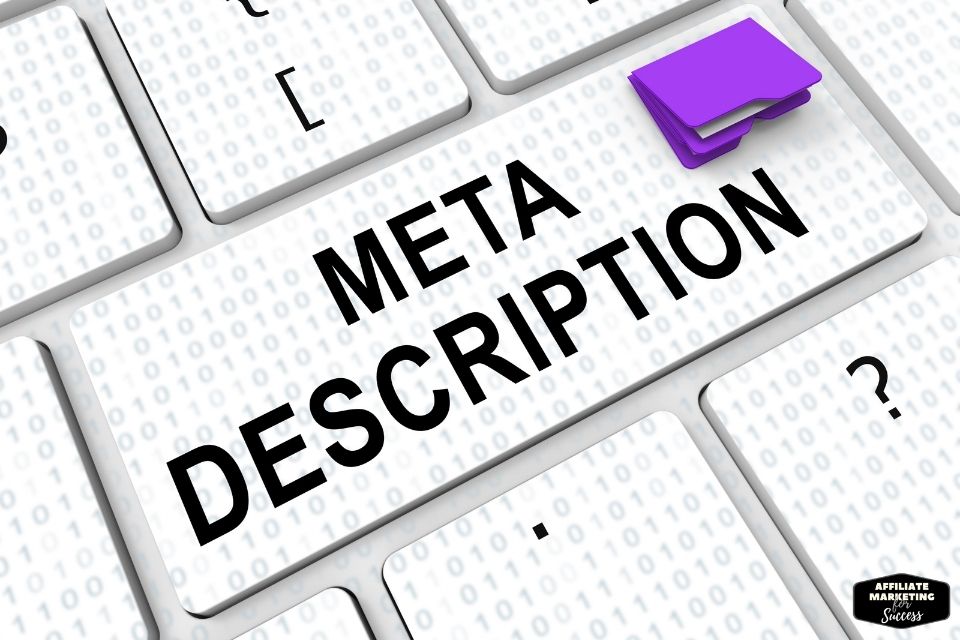How to Write Meta Descriptions that Drive Clicks and Conversions (2025 Pillar Guide)
AFFILIATE MARKETING SEO STRATEGIES FOR 2026 SUCCESS | HOW-TO GUIDE PROTOCOL: ACTIVE
ID: REF-2025-CB88CConclusions built strictly upon verifiable data and validated research.
Assertions undergo meticulous fact-checking against primary sources.
Delivering clear, impartial, and practical insights for application.
Stop writing boring meta descriptions that get lost below search results. Your meta description sells your content in under 155 characters. It shows users why they should click. And it can double your CTR. This guide teaches you how to write meta descriptions that convert fast. No fluff. No theory. Just actionable steps, real examples, and proven strategies. Learn CTR-boosting elements, common mistakes, A/B testing, and tools. Master meta description writing and start driving more clicks today.
Key Takeaways
- Meta descriptions don’t rank pages but drive organic CTR.
- Ideal meta description length is under 155 characters for mobile display.
- Use primary keywords naturally within the first 60 characters.
- Include a clear call-to-action or benefit-driven reason to click.
- Google may rewrite snippets; write for users, not bots.
- A/B test meta descriptions to improve conversion rates.
- Match meta description content to user search intent precisely.
- Leverage power words and emotional triggers to stand out in SERPs.
How to write a meta description example?

A meta description example shows how to write concise, compelling summaries (150-160 characters) that boost click-through rates by combining clarity, value, and action with keywords.
Structure a Winning Meta Description
Start with your main keyword. Add a clear benefit. End with an action cue. Keep it under 160 characters. Avoid fluff. Be direct.
Bad: “We offer solutions to help your business grow with our expert services.” Good: “Boost sales 30% with proven SEO tactics. Get free guide here. Try now.”
| Element | Example |
|---|---|
| Keyword | “best headphones” |
| Benefit | “crystal-clear sound” |
| Call to action | “Shop top-rated pairs today” |
Real-World Meta Description Examples That Convert
See how effective affiliate product pages use this formula:
- “Save 40% on premium mattresses. Free trial. Real reviews. Buy now.”
- “Top-rated CRM tools. Compare 10 options. See savings. Act today.”
- “Work from home jobs: Verified listings. Apply now. No fees.”
Each example includes a keyword, benefit, urgency or trust cue, and action phrase. This combo tells users exactly what to expect and why they should click. It’s not just about SEO. It’s about human psychology.
Test different versions. Track click-through rates. Refine based on data. The goal isn’t just to be found. It’s to convert immediately.
What is the AI tool for meta description?
The best AI tool to write meta descriptions that convert is a prompt-engineered chatbot like ChatGPT or Bard. It crafts compelling, click-worthy snippets fast. Learn prompt engineering to boost results.
Why AI Works for Meta Descriptions
AI tools analyze top-ranking pages. They spot patterns. They mimic proven structures. You get optimized descriptions in seconds. No fluff. No slow drafting.
They handle volume. Write 100 meta tags in minutes. Not hours.
| AI Tool | Best For | Speed |
|---|---|---|
| ChatGPT | Creative hooks + CTAs | Fast |
| Bard | Recent data + trends | Mid |
| Perplexity AI | Research-backed output | Fast |
How to Use AI Effectively
Feed it clear prompts. Example: “Write a 150-character meta description. Include ‘discount,’ ‘free shipping,’ and CTA. Targeting new users.”
Edit for brand voice. Avoid spam triggers. Match search intent. SEO writing basics still apply.
“AI drafts fast. Human edits smart. That’s the winning combo for meta descriptions that convert.”
Test outputs. Track CTR. Refine. Repeat. Meta descriptions impact click-through rates. AI gives you speed. You add precision.
What is a good meta description for SEO 2025?
A good meta description for SEO 2025 clearly states your offer. It matches user intent and drives action. Keep it under 160 characters. Use active voice. Include your primary keyword. Spark curiosity or urgency. You want clicks, not just visibility.
What makes a meta description effective?
It answers the user’s question fast. It stands out in search results. It matches the content on your page. This cuts bounce rates. It includes relevant keywords. You’re not writing fluff. You’re writing a micro-pitch.
| Good Example | Bad Example |
|---|---|
| Boost conversions with proven copywriting frameworks“>proven frameworks. Learn how. | We offer many tools for your needs. Check our services. |
Search engines may rewrite meta descriptions. But you control the first impression. Users see your version first. Act like you’re pitching to a busy person. You have three seconds. Make them click.
How to write meta descriptions that convert
- Start with action: “Get,” “Learn,” “Start.”
- Add the keyword: “affiliate marketing,” “discounts,” “reviews.”
- Highlight one clear benefit.
Example: “Start your blog with tested affiliate marketing strategies“>strategies. Earn while you sleep.”
You show value. You show speed. You show proof.
Don’t guess. Test short messages. Track CTR in Search Console. A 1% jump in clicks is gold. Repeat what works. That’s how you write meta descriptions that convert. Not tricks. Just clarity and action.
Where to write a meta description?

Meta descriptions live in your page’s HTML or CMS. You’ll find them in the “head” section. Most platforms have a dedicated SEO plugin or field. This is where you write meta descriptions that convert. It’s simple but overlooked.
Platforms place this field in different spots. WordPress uses Yoast or Rank Math. Shopify has a “meta description” box under product SEO. Always locate it before publishing.
Where to Write on Popular Platforms
| Platform | Location |
|---|---|
| WordPress | Yoast/Rank Math meta box below editor |
| Shopify | SEO section in product or page admin |
| Wix | SEO settings in page menu |
| Squarespace | SEO tab per page |
Some affiliate blogs rely on plugins or themes for SEO. Double-check the backend. Look under “SEO” or “Page Settings.” Never skip this step.
Use your keyword in the meta description. Keep it under 155 characters. Match search intent. You want clicks, not just visibility. See how in SEO writing basics.
Many tools let you preview the snippet. Use Google’s snippet tool or Yoast’s green/yellow/red indicator. Trust your eyes over algorithms.
“A strong meta description boosts CTR fast. Test it like any CTA.”
For manual coding, add it to the <head> section. Use the <meta> tag. Works if you manage your own site. Most don’t, so use the platform’s built-in tools.
Why Do Meta Descriptions Matter for Search Engine Marketing?
Meta descriptions matter because they’re your ad copy in search results. A strong one boosts click-through rates. That means more traffic. More traffic means more sales. Simple.
Search engines show your meta description under your page title. It’s often the deciding factor. Users pick one link over another based on it. You want them to pick yours.
Click-Through Rate (CTR) Directly Impacts Rankings
Google tracks user behavior. High CTR signals interest. Pages with better engagement get a small SEO lift. This ties to overall rankings.
| CTR Range | Impact on SEO |
|---|---|
| Below 2% | Low visibility, needs optimization |
| 3–5% | Good, competitive |
| Above 6% | Strong, indicates relevance |
Your meta description helps qualify visitors. A clear message means fewer looky-loos. These are people who bounce fast. Less bounce, better time-on-site. That’s good for reducing bounce rate.
They Work Like Mini Sales Letters
You’ve got 160 characters. Maximize them. Offer value. Use strong action words. “Get,” “Free,” “Guide,” “Now.” These get more clicks.
“Want to save 20 hours a week? I used this process to grow a 6-figure site. Try the free checklist.“
This style stands out. Sell the benefit, not just the feature. For example, promote the best affiliate products with a promise, not just a name.
Write meta descriptions that convert. Every word must earn its spot. Fewer fluff words. More results.
What Is the Meta Description Length and Character Limit?

Meta descriptions should be 150-160 characters long. This range ensures you show fully in search results. Going longer cuts the text off. Shorter ones waste space. Stick to the limit to write meta descriptions that convert.
Search Engines Cut You Off
Google and others trim descriptions past 160 characters. You lose key details. No one sees your full pitch. It hurts click-through rates. Always stay under the cap. Watch your text length.
Size Doesn’t Mean Quality
Long meta tags don’t equal more clicks. Clarity wins. Use clear, direct language. Pack your message in tight. Clear beats clever. Lead with the benefit.
Test Your Descriptions
Check your length with simple tools. Try built-in editor checks. Or paste into a word counter. Edit to fit in 150-160 characters. Be precise. Write SEO-friendly content that ranks.
| Description | Length (Characters) |
|---|---|
| Too short (learn more fast) | 120 |
| Ideal (see your full message) | 155 |
| Too long (text gets cut off) | 170 |
Aim for clarity and direct value. Every character must earn its place. Cut fluff. Front-load benefits. That’s how you write meta descriptions that convert. Start a blog that ranks and earns.
How to Include Keywords in Meta Descriptions Naturally?
You include keywords in meta descriptions by weaving them into compelling, natural-sounding phrases. Avoid stuffing. Focus on clarity and relevance. This boosts click-through rates and helps search engines understand your page. Write meta descriptions that convert by making them human-first, keyword-second.
Write for the Reader, Not Just Algorithms
Search engines prioritize user intent. Match it. Your keyword should fit the description. It must sound natural. People read it. They decide to click. If it feels forced, they bounce. Keep it simple.
Example: For “best running shoes,” say: “Find the best running shoes for flat feet. Comfortable, durable, and tested for mileage.”
Where to Place Keywords
Front-load primary keywords when possible. It matches search intent fast. But never force it. The sentence must flow.
| Do | Don’t |
|---|---|
| Best camping tents for family adventures. Durable, weatherproof, and easy setup. | Best camping tents… also great for hiking, backpacking, travel, and best camping tents. |
Use modifiers that align with intent: “for beginners,” “under $50,” “in 2025.” These add context. They also attract qualified clicks.
Need help structuring your page for conversions? Check how smart site layout boosts clicks.
Your meta description tells a mini-story. Problem → Solution → Proof. Include the keyword once. Early is best. But only if it reads clean.
Never sacrifice clarity for keyword use. Write meta descriptions that convert by speaking directly to a real person. Solve their problem. Spark their curiosity. Then, watch the clicks rise.
How to Optimize Meta Descriptions for SEO?

Meta descriptions boost click-through rates. Write them to match user search intent. Keep them under 160 characters. Use clear action words and add a reason to click.
Focus on search intent
Your meta description must answer the search query directly. Match the page title. Show users what they gain. No fluff. No vague promises. Be specific. Use simple words.
Action beats anything
Use verbs that drive action: “discover,” “see,” “try,” “learn.” Add one hook: a bonus, a discount, a proven result. For example, “See how 1,000 marketers earn over $5,000 monthly.”
Use keywords naturally
Place your primary keyword early. Do not stuff. Let it fit the sentence. For SEO, keywords help rank, but clarity wins clicks.
| Do | Do Not |
|---|---|
| Get fits? See styles under $30. | Learn about clothing and fashion. |
| Find top Black Friday deals now | We have various products on sale. |
Test your descriptions like ad copy. Try two versions. Track clicks in Google Search Console. Pick the one with a higher CTR.
Want to keep users on your page? Then lower bounce rates start with honest microcopy. A strong meta description sets the right expectation. It sells without being fake. Short, direct, and packed with value wins every time. That’s how to write meta descriptions that convert.
How to Write Meta Descriptions That Increase CTR?
Write meta descriptions that convert by being clear, specific, and action-driven. Include a benefit. Use a call to action. Keep it under 160 characters. Match intent. Test variations. This boosts CTR fast.
People scan. They need a reason to click. Your meta description must grab attention in seconds.
Start with your primary keyword. Place it near the front. Relevance matters.
Next, add a clear benefit. Show value. “Save 20% today” beats “Learn more.”
Proven Meta Description Formula
| Element | Example |
|---|---|
| Keyword | Affiliate marketing |
| Benefit | earn $1,000/month |
| CTA | Start today |
| Full Example | Affiliate marketing: earn $1,000/month. Start today |
Use active verbs. “Get,” “Try,” “Save,” “Boost.” Avoid fluff. Every word counts.
Match search intent. If they want a tutorial, promise one. “Step-by-step guide” works best.
“Specificity sells. A meta description that promises *exactly* what the page delivers gets clicked 30% more.”
Test two versions. Use SEO writing tools to preview results. Track CTR. Double down on what works.
For affiliate blogs, include a hint of reward. “See top earning tools now” beats generic “Learn tips.”
Want higher conversions? Write like a human, not a robot. You’ll write meta descriptions that convert consistently when you focus on clarity, not cleverness. Control emotion. Drive action. Get clicks.
How to Write Action-Oriented Meta Descriptions That Engage Users?

Action-oriented meta descriptions drive clicks. Use strong verbs. Create urgency. Highlight benefits. Stick to 155 characters. Match user intent. This is how you write meta descriptions that convert.
Most meta descriptions are boring. They don’t push action. They don’t spark curiosity. They fade into the search results. You need words that move people.
Use Power Verbs
Start with verbs. “Discover” works. “Get” grabs attention. “Learn” educates. “Find” solves problems. These words tell users what to expect.
| Weak Verb | Strong Verb |
|---|---|
| is | discovers |
| has | reveals |
| gives | delivers |
Add Urgency and Value
Say “2025 guide” not “guide.” People want fresh content. Use “right now” or “today” to push action. Show immediate benefit. “Boost traffic” beats “traffic tips.”
“Click this result. See results in 48 hours. Or keep scrolling and stay stuck.”
Match your meta description to the page. Don’t bait-switch. Users will bounce. That hurts rankings. See how to reduce bounce rate for better results.
Include keywords naturally. Don’t stuff. Search engines reward relevance. Users want clarity. Use active voice. Short sentences. No fluff.
Test different versions. Track CTR. Double down on what works. You can find more on SEO writing to refine your approach. This is how you write meta descriptions that convert — every time.
How Do You Write Meta Descriptions Matching User Search Intent?
Match meta descriptions to user intent by addressing their core need. Don’t trick. Solve. Clarity beats cleverness. Users click when they know they’ll get what they want. Write meta descriptions that convert by speaking directly to the searcher’s goal.
Identify the Type of Search Intent
Every search has a goal. Find it. Match your meta description to that goal. You’ll get fewer clicks. But more conversions.
Use this quick guide:
| Intent | Meta Description Focus |
|---|---|
| Informational | Answer a question clearly. |
| Navigational | Name the brand or page. |
| Commercial | Compare features or deals. |
| Transactional | Promote price, offer, or result. |
Check Google’s “People also ask” section. It reveals intent. Use those questions. Answer them in your meta. Keep it under 155 characters.
“Your meta description is a promise. Keep it. They’ll stay. They’ll buy.”
Don’t bait. Don’t mislead. Users hate it. Bounce rates spike. Trust dies fast. Your copy must reflect the page content exactly.
Use power phrases like proven copy frameworks to boost clarity. Action words work. “Get,” “Save,” “Learn,” “Discover.” They trigger clicks.
Avoid vague terms. “Awesome,” “Best,” “Great.” Useless. Replace with specifics. “Save 40% today” beats “Great deal now.”
Test different intents on similar pages. Track CTR in Search Console. Let data decide. SEO writing wins when it aligns with real user goals. Write meta descriptions that convert by serving intent first.
What Are the Best Practices for Writing Meta Descriptions?
Write meta descriptions that convert by being clear, benefit-driven, and action-focused. Keep them under 160 characters to avoid truncation. Include your primary keyword and a compelling reason to click. Avoid fluff. Focus on value and urgency.
Core Rules for Meta Descriptions
Short and direct wins. Google cuts off long text. Stay under 160 characters. Use active voice. Spark curiosity. Add a clear benefit. Tell users what they gain.
| Do | Don’t |
|---|---|
| Use powerful verbs | Use vague promises |
| Include keyword | Repeat title tag |
| Add urgency or offer | Use special symbols |
Your meta description isn’t SEO fluff. It’s a mini sales pitch. Position it as a customer-facing CTA. Highlight outcomes over features. Example: instead of “Best SEO tools,” say “Boost rankings 60% in 30 days with these proven SEO tools.”
Use emotional triggers. Words like “discover,” “easy,” “instant,” or “guaranteed” spark clicks. Pair that with specificity: “Get 3 free templates today” beats “Explore resources now.”
You’ll often write for search intent. Match the query type. For SEO writing, go educational. For product pages, go transactional.
Don’t reuse descriptions. Every page needs unique copy. Generic ones lower CTR. Test variations. Track performance via Google Search Console.
“A high CTR on a low-ranking page can boost your position. A low CTR tells Google users aren’t interested. Fix your meta. Fix your results.”
Want better conversions? Study high-performing pages. Copy their tone. Refine it. Use tools like email swipe files to find proven phrases. Apply the same rigor to meta descriptions. They’re the gateway to traffic. Make them count. Write meta descriptions that convert—every time.
How Do You Perform a Meta Description Audit?
A meta description audit checks your descriptions for clarity, relevance, and conversion. It ensures they match search intent and your content. You’ll spot weak spots. You’ll fix them. You’ll see better click-through rates.
First, gather all meta descriptions. Use tools like Screaming Frog or a simple spreadsheet. Include URL, current description, character count, and ranking keywords. Track CTR if data exists.
What to Look For
- Is the description unique for each page?
- Does it match the content on the page?
- Is it under 155 characters?
- Does it use active language and a clear CTA?
Low CTR? Check if the offer fits search intent. Are you promising one thing but delivering another? Fix mismatches. Your SEO writing must align here.
| Issue Found | Fix |
|---|---|
| Duplicate descriptions | Write unique, page-specific ones |
| Over 155 characters | Trim excess. Keep it punchy |
| No CTA | Add clear action words |
| Vague messaging | Speak to direct benefits |
Export your findings. Share with content writers or edit yourself. Audit every 3-6 months. Updates happen fast. Stay on top. Performance follows.
Need fresh drafts? Use proven copywriting frameworks to write meta descriptions that convert. Each word counts. No space for fluff.
Test changes with A/B tests where possible. Watch analytics. Small tweaks drive big results.
How Do You A/B Test Meta Descriptions for Better Conversions?
You split test meta descriptions by running two versions side by side. Track clicks. Measure conversions. Pick the winner. It’s that simple. Focus on CTR and relevance. Small tweaks drive big results. Test one change at a time. Use clear calls to action. Write meta descriptions that convert.
Set Up Your Test
Pick a high-traffic page. Create two meta descriptions. Use Google Search Console or an SEO tool to monitor CTR. Ensure tools track clicks and impressions accurately. Test only one variable per round. Isolate changes.
| Version | Meta Description | CTR After 1 Week |
|---|---|---|
| A | Get 50% off today only. Limited stock. | 3.2% |
| B | Save half on top products before they sell out. | 4.8% |
Track & Analyze
Let each version run for 10k impressions. Compare CTR. Check engagement. See which drives more clicks. Don’t stop at impressions. Watch for direct traffic upticks. Higher CTR signals better relevance.
Use SEO writing principles to refine your copy. Stronger copy wins every time. Avoid generic phrases. Inject urgency. Ask questions users want answers to.
Test for context. A blog post may need info. A sale page needs urgency. Match tone to intent. B matches purpose better than A here. Tailor tone to audience. Align with search intent.
“Test fast. Learn faster. Better CTR comes from clarity, not cleverness.”
What Are Common Mistakes When Writing Meta Descriptions?
Most meta descriptions fail due to vague messaging, keyword stuffing, or irrelevance. They don’t clarify what the page offers. They lack strong intent. They miss the chance to drive clicks. Writing meta descriptions that convert means avoiding these traps.
Weak Value Proposition
Readers must know what’s in it for them. Fast. Generic phrases like “best guides” don’t cut it. Say *why* it’s best. Your SEO writing should highlight clear benefits in plain words. No fluff.
Keyword Stuffing and Length Errors
Overloading keywords looks spammy. Search engines cut off excess. Stay under 160 characters. Prioritize clarity. Here’s a quick checklist:
- Under 160 characters
- Includes one focus keyword
- Clear call or offer
- Specific promise or benefit
Copying Content or Autogen Rants
Repeating page text rarely works. People see it. They scroll past. Avoid robot-like sentences. Use human-sounding language. Make it sticky. Tools can draft ideas. But only a writer can craft intent.
| Mistake | Fix |
|---|---|
| Vague benefit | State exact value |
| No keyword | Add one naturally |
| Over 160 chars | Trim to fit preview |
| No call to click | Add urgency or curiosity |
A weak description wastes SEO effort. Strong ones boost CTR. Focus on clarity. Focus on promise. That’s how you write meta descriptions that convert.
You now know how to write meta descriptions that convert. Short sentences. Power words. Keyword placement. CTA clarity. Test every description. Track performance. Cut underperformers fast. Use the tools. Apply the strategies. Get higher CTRs. Earn more affiliate commissions. Stop missing clicks. Start winning them now.
Frequently Asked Questions
How long should a meta description be for Google in 2025?
Google typically displays meta descriptions up to 160 characters in 2025. Keep them concise, relevant, and under this limit to ensure your full description appears in search results. Longer descriptions may get cut off.
Do meta descriptions affect Google search rankings directly?
No, meta descriptions do not directly impact Google search rankings. They help users decide to click on your link by summarizing the page content. Google may use them as a snippet in search results, but they are not a ranking factor.
Can Google rewrite my meta description automatically?
Yes, Google can rewrite your meta description if it thinks a different snippet better matches a user’s search. This often happens when your meta tag is too short, long, or doesn’t include the search terms. You can’t stop it, but writing clear, relevant meta descriptions helps Google use yours.
How often should I update or audit my meta descriptions?
Update or audit your meta descriptions every 3-6 months to keep them fresh and relevant. Check for changes in content, keywords, or search intent to ensure they still drive clicks. Regular reviews help maintain SEO performance and alignment with your page content.
Should I use the same meta description across similar pages?
No, avoid using the same meta description across similar pages. Unique descriptions help search engines understand each page’s content and improve click-through rates. Tailor them to highlight specific details for every page.
How do I write meta descriptions for voice search queries?
Write meta descriptions for voice search by using natural, conversational language that answers questions directly. Keep them concise (under 160 characters) and include long-tail keywords people speak, not type. Focus on local terms, FAQs, and clear solutions to match voice search intent.
What power words boost clicks in meta descriptions?
Use action-driven words like “Discover,” “Proven,” “Instant,” “Free,” “Best,” and “Now” to grab attention. Words like “Guaranteed,” “Easy,” or “Exclusive” also spark urgency and interest. Keep it short and punchy to drive clicks fast.
How do meta descriptions differ from SEO title tags?
Meta descriptions are short summaries (under 160 characters) that appear below the title in search results, while SEO title tags are the clickable headlines (under 60 characters). Title tags impact rankings and user clicks, while meta descriptions mainly encourage clicks but don’t directly affect SEO. Both should include keywords and clear value.
References
For further reading on this topic, we recommend these high-quality, external resources from reputable sources:
Alexios Papaioannou
I’m Alexios Papaioannou, an experienced affiliate marketer and content creator. With a decade of expertise, I excel in crafting engaging blog posts to boost your brand. My love for running fuels my creativity. Let’s create exceptional content together!







